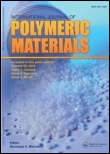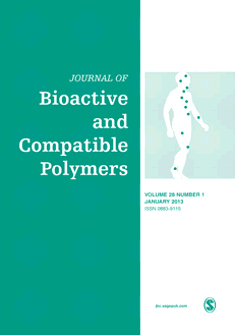
MOLECULES
Scope & Guideline
Empowering Researchers to Explore the Chemistry Frontier
Introduction
Aims and Scopes
- Polymer Chemistry and Engineering:
Research that explores the synthesis, characterization, and application of various polymers, including biopolymers, thermoresponsive polymers, and hydrogels, often aimed at biomedical applications. - Biomaterials and Drug Delivery Systems:
Investigations into the design and functionality of biomaterials for drug delivery, tissue engineering, and regenerative medicine, focusing on biocompatibility and therapeutic efficacy. - Self-Assembly and Nanotechnology:
Studies on the self-assembly of molecular structures, including nanoparticles and nanocomposites, and their applications in drug delivery, imaging, and diagnostics. - Environmental and Sustainable Chemistry:
Research that addresses the sustainability of materials, including the use of renewable resources and the development of biodegradable polymers. - Molecular Interactions and Dynamics:
Exploration of molecular interactions at the nanoscale, including studies on protein-polymer interactions, phase behavior, and the dynamics of macromolecules. - Innovative Analytical Techniques:
Development and application of advanced analytical techniques for characterizing materials and understanding molecular behavior in various environments.
Trending and Emerging
- Stimuli-Responsive Materials:
Research on materials that respond to environmental stimuli (pH, temperature, light) is increasingly prominent, driven by applications in smart drug delivery and adaptive biomaterials. - Nanotechnology and Nanomedicine:
The integration of nanotechnology in drug delivery systems and therapeutic applications is a rapidly growing area, reflecting advances in targeted therapy and precision medicine. - Biobased and Sustainable Polymers:
There is a growing emphasis on developing polymers from renewable resources, highlighting sustainability and environmental impact, which aligns with global initiatives for greener materials. - Advanced Biomaterials for Tissue Engineering:
Innovations in biomaterials aimed at improving tissue regeneration and repair, particularly in the context of chronic wounds and regenerative medicine, are increasingly being published. - Multifunctional and Hybrid Materials:
The trend towards multifunctional materials that combine properties (e.g., antibacterial, conductive, biodegradable) for diverse applications is on the rise, reflecting interdisciplinary research efforts. - Molecular Delivery Systems:
Research focusing on the development of efficient systems for the delivery of nucleic acids and proteins, particularly in gene therapy and vaccination strategies, is becoming more prominent.
Declining or Waning
- Traditional Synthetic Polymers:
Research focusing solely on conventional synthetic polymers is becoming less frequent as the field shifts towards more complex, multifunctional materials that integrate bioinspired and sustainable approaches. - Basic Polymer Physics:
Studies that primarily address fundamental polymer physics without application to advanced materials or biomedical contexts are less prevalent, indicating a move towards application-driven research. - General Material Characterization:
Papers that provide generic characterization methods without linking to specific applications or innovations are decreasing, as the journal favors studies with clear relevance to current challenges in molecular science. - Exclusively Academic Theoretical Studies:
Theoretical studies that do not incorporate experimental validation or practical implications are seeing reduced publication frequency, highlighting a preference for research that bridges theory and practice.
Similar Journals

International Journal of Polymeric Materials and Polymeric Biomaterials
Exploring the Boundaries of Polymer ScienceThe International Journal of Polymeric Materials and Polymeric Biomaterials, published by Taylor & Francis AS, stands at the forefront of materials science, showcasing groundbreaking research in the fields of Analytical Chemistry, Chemical Engineering, and Polymeric Materials. With an ISSN of 0091-4037 and an E-ISSN of 1563-535X, this esteemed journal, established in 1971, serves as a vital platform for academics and professionals seeking to disseminate innovative findings and elevate the understanding of polymeric materials. Featuring a commendable impact factor and ranking in the top quartiles of its categories—Q2 in Analytical Chemistry, Chemical Engineering, and Polymers and Plastics—the journal is a pivotal resource for researchers aiming to leverage polymer science in various applications. Although it does not offer open access, its rigorous peer-review process ensures that only high-quality research is published, making it an essential reference for anyone involved in polymer research and development.

PHARMACEUTICAL CHEMISTRY JOURNAL
Advancing Drug Discovery Through Scholarly Excellence.Pharmaceutical Chemistry Journal is a pivotal publication in the field of pharmaceutical sciences, renowned for its in-depth articles and research findings. Published by Springer in the United States, this journal provides a crucial platform for researchers, students, and professionals dedicated to advancing drug discovery and pharmacology. With an ISSN of 0091-150X and an E-ISSN of 1573-9031, this journal has consistently aimed to promote scholarly communication and innovation within its scope since its inception in 1967. Despite its current Category Quartiles ranking of Q4 in both Drug Discovery and Pharmacology, the journal remains a valuable resource for disseminating new ideas and findings that contribute to the scientific community. Researchers benefit from the journal's commitment to high-quality peer-reviewed content, even in an environment where open access options are currently not available. As the field evolves, the Pharmaceutical Chemistry Journal continues to play an important role in shaping future advancements in drug development and safety.

Inorganic and Nano-Metal Chemistry
Connecting Ideas in Inorganic Chemistry and Nanotechnology.Inorganic and Nano-Metal Chemistry is a premier journal published by Taylor & Francis Inc, focusing on innovative research and advancements in the fields of inorganic chemistry and nano-metal applications. With an increasing impact in the academic community, this journal has established itself within the Q3 category of both Inorganic Chemistry and Physical and Theoretical Chemistry as of 2023, reflecting its global recognition and influence. The journal is accessible as an Open Access publication, ensuring that research findings are freely available to a broad audience, promoting transparency and collaboration in scientific exploration. Based in the United Kingdom, Inorganic and Nano-Metal Chemistry aims to disseminate high-quality peer-reviewed articles that not only highlight fundamental studies but also push the boundaries of technological applications in areas such as catalysis, materials science, and nanotechnology. Researchers, professionals, and students will find this journal an invaluable resource for the latest developments and interdisciplinary insights in the ever-evolving landscape of inorganic and nano-metal chemistry.

ACS Bio & Med Chem Au
Driving innovation in therapeutic strategies through rigorous research.ACS Bio & Med Chem Au, published by the esteemed American Chemical Society, stands at the forefront of interdisciplinary research within the realms of biochemistry, drug discovery, pharmaceutical sciences, and molecular biology. With an impressive Impact Factor indicative of its rigorous academic standards and significant contributions to the field, this open-access journal is committed to disseminating high-quality research that drives innovation and advancements in biosciences and medicinal chemistry. Since its inception in 2021, the journal has rapidly earned recognition, achieving a commendable Q1 ranking in multiple categories, including Biochemistry, Drug Discovery, and Pharmaceutical Science, while also making strides in Molecular Biology. Researchers, professionals, and students alike can explore pioneering studies that bridge gaps between laboratory research and clinical applications, fostering collaborative efforts towards novel therapeutic strategies. With a focus on enhancing accessibility and engagement within the scientific community, ACS Bio & Med Chem Au is poised to impact the future of biomedical research significantly.

JOURNAL OF BIOACTIVE AND COMPATIBLE POLYMERS
Advancing the Frontiers of Polymer ScienceJOURNAL OF BIOACTIVE AND COMPATIBLE POLYMERS, published by SAGE PUBLICATIONS LTD, serves as a pivotal platform for disseminating innovative research in the fields of bioengineering, biomaterials, materials chemistry, and polymers. With an ISSN of 0883-9115 and an E-ISSN of 1530-8030, this journal is committed to the advancement of knowledge relating to the interaction of polymers within biological systems and their compatibility in various applications. Operating since 1986, the journal has garnered a respectable presence, ranked in the Q3 quartile across multiple categories in 2023, indicating its relevance and contribution to these dynamic fields. Although not open access, the journal ensures that high-quality research is accessible to subscribers and institutions, reinforcing its importance for researchers, professionals, and students aiming to stay abreast of advancements in polymer science and biocompatibility. By fostering interdisciplinary communication and collaboration, the JOURNAL OF BIOACTIVE AND COMPATIBLE POLYMERS continues to play a crucial role in shaping the future of material applications in health, technology, and industry.

BIOMACROMOLECULES
Catalyzing Collaboration in the World of BiomacromoleculesBIOMACROMOLECULES, published by the American Chemical Society, stands as a premier journal in the fields of bioengineering, biomaterials, materials chemistry, and polymers and plastics. With a commendable impact factor that places it in the Q1 category across these disciplines, it is recognized for its influential research contributions and is ranked strongly within its scopes—16th in Polymers and Plastics and 26th in Biomaterials according to Scopus. Since its inception in 2000 and continuing through 2024, the journal has been pivotal in disseminating significant findings and technological advancements that propel the field forward. Although it does not currently have an open access option, the journal offers invaluable insights that are essential for researchers, professionals, and students engaged in the cutting-edge exploration of macromolecules and their diverse applications. With its address located at 1155 16th St, NW, Washington, DC 20036, BIOMACROMOLECULES is not just a repository of knowledge but also a vital platform for fostering collaboration and innovation within the scientific community.

Journal of the Iranian Chemical Society
Connecting Chemists to Drive InnovationThe Journal of the Iranian Chemical Society, published by SPRINGER, is a prominent academic journal dedicated to advancing the field of chemistry. With an ISSN of 1735-207X and an E-ISSN of 1735-2428, this quarterly journal has been contributing valuable research from 2006 to 2024. Situated in Germany, it serves as a vital platform for chemists and researchers to disseminate their findings, particularly within the miscellaneous chemistry category, where it ranks in the Q3 quartile for 2023. Despite its current lack of open access options, the journal maintains a solid presence in the academic community, evidenced by its Scopus ranking of #165 out of 408 in general chemistry and a commendable 59th percentile. The journal's objective aims to foster innovation and collaboration in chemical research, making it an essential resource for professionals and students keen on pioneering developments in the field. As a subscriber, you will gain insights into cutting-edge research that drives the future of chemistry.

BMC Chemistry
Empowering Discoveries in the World of ChemistryBMC Chemistry, published by BMC, is a reputable open access journal that has made significant strides since its inception in 2019. Operating under e-ISSN 2661-801X, this journal is dedicated to advancing the field of general chemistry by promoting high-quality research across various sub-disciplines. Headquartered in the United Kingdom, BMC Chemistry boasts a commendable impact factor and is classified in Q2 within the prestigious field of Chemistry (miscellaneous) according to the 2023 category quartiles. The journal's Scopus ranking places it at #139 out of 408 in its category, highlighting its growing relevance and influence in the academic community, with a commendable 66th percentile standing. With a commitment to open access, BMC Chemistry ensures that groundbreaking discoveries and innovative research are available to a global audience, fostering collaboration and development in chemistry. Researchers, professionals, and students alike will find this journal to be an invaluable resource for disseminating knowledge and driving scientific advancement.

Carbohydrate Polymer Technologies and Applications
Unlocking Potential: The Science of Carbohydrate PolymersCarbohydrate Polymer Technologies and Applications, published by ELSEVIER, is an esteemed open access journal that has been fostering innovation in the field of carbohydrate polymer research since its inception in 2020. With its ISSN 2666-8939, this journal is dedicated to exploring the intersections of analytical chemistry, biochemistry, biotechnology, and materials science, making significant contributions to our understanding of carbohydrate polymers and their diverse applications across various industries. Notably, it has attained a prominent position in various categories, reflecting its quality and impact: ranked Q1 in Analytical Chemistry, Biotechnology, and several Materials Science disciplines, while maintaining strong positions in the Q2 and other quartiles. Additionally, with impressive Scopus rankings—14th in Chemistry (miscellaneous) and 23rd in Analytical Chemistry—it stands at the forefront of scholarly dialogue in these areas, appealing to researchers, professionals, and students alike. The journal's commitment to open access facilitates wider dissemination of knowledge and enhances collaborative research, solidifying its role as a pivotal resource for advancing carbohydrate polymer technologies.

Journal of Macromolecular Science Part A-Pure and Applied Chemistry
Catalyzing Knowledge in Polymers and PlasticsWelcome to the Journal of Macromolecular Science Part A - Pure and Applied Chemistry, a distinguished publication dedicated to advancing the understanding of macromolecular science, encompassing critical areas such as polymers, materials chemistry, and composites. Published by Taylor & Francis Inc, this journal has firmly established its place within the scientific community, evident from its ranking in the Q2 and Q3 quartiles across various categories in the latest assessments, including Polymers and Plastics as well as Ceramics and Composites. With a commitment to providing high-quality peer-reviewed content, the journal aims to facilitate knowledge exchange and innovation among researchers and practitioners from around the globe. The absence of open access underscores the journal's commitment to maintaining rigorous editorial standards while remaining accessible to its readership. As the journal converges through valuable research contributions from 1992 to 2024, it continues to be a pivotal resource for professionals and students seeking to explore the latest advancements and applications in the field of macromolecular science.